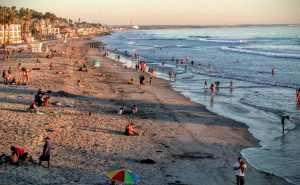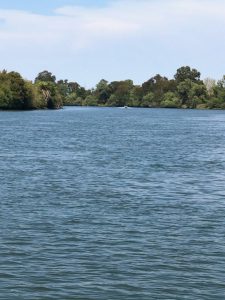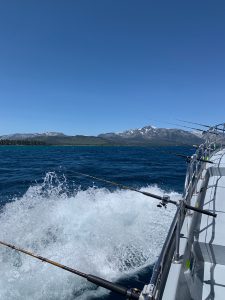
Public Access
The Commission’s core purpose is to protect the lands and resources entrusted to its care through balanced management, marine protection and pollution prevention, adaptation to climate change, and ensuring public access to these lands and waters for current and future generations of Californians. The Commission is dedicated to safeguarding and promoting the public’s access rights to waterways and the coastline.
- A legal guide to the public’s rights to access and use California’s navigable waters
- Public Access Brochure | en Español
For hard copies of these publications contact staff at CSLC.PublicAccess@slc.ca.gov or 916.574.1900.
What is the Public Trust?
 The public’s right to use California’s waterways for navigation, fishing, boating, natural habitat protection and other water-oriented activities is protected by the Common Law doctrine of the Public Trust. Historically, the Public Trust has referred to the basic right of the public to use its waterways to engage in “commerce, navigation, and fisheries.” More recently, the doctrine has been broadened by various landmark court decisions to include the right to swim, boat, and engage in other forms of water recreation, and even to preserve lands in their natural state in order to protect scenic and wildlife habitat values. The Public Trust provides that tide and submerged lands and the beds of lakes, streams and other navigable waterways are to be held in trust by the State for the benefit of the people of California. The Public Trust, as a common law doctrine, is not static but is continuously evolving to protect the public’s use and needs in California’s waterways.
The public’s right to use California’s waterways for navigation, fishing, boating, natural habitat protection and other water-oriented activities is protected by the Common Law doctrine of the Public Trust. Historically, the Public Trust has referred to the basic right of the public to use its waterways to engage in “commerce, navigation, and fisheries.” More recently, the doctrine has been broadened by various landmark court decisions to include the right to swim, boat, and engage in other forms of water recreation, and even to preserve lands in their natural state in order to protect scenic and wildlife habitat values. The Public Trust provides that tide and submerged lands and the beds of lakes, streams and other navigable waterways are to be held in trust by the State for the benefit of the people of California. The Public Trust, as a common law doctrine, is not static but is continuously evolving to protect the public’s use and needs in California’s waterways.
History of the Public Trust
Historic public rights in Great Britain’s waterways are important in California today because California adopted English Common Law in 1850. Under Common Law, the King was the trustee for public rights in waterways. In this tradition, California’s navigable beds of waterways are called Sovereign Lands. They became state property when California joined the Union on September 9, 1850, and are held by the State in trust for the people. Since 1938, the Commission has been the administrator and guardian of these valuable public lands. The Commission has administrative jurisdiction over the State’s Public Trust lands and has oversight authority over sovereign lands granted in trust by the Legislature to local governments. The Commission acts pursuant to the California Constitution, legislation, and the Public Trust Doctrine to protect the public’s interest in trust lands.
What are Public Trust Lands?
 In coastal areas, sovereign lands include both tidelands and submerged lands, from the shore out three nautical miles into the Pacific Ocean and lands that have been filled and are no longer underwater. Tidelands lie between mean high tide and mean low tide. The beds of navigable lakes and rivers are also sovereign lands subject to the Public Trust. Both the state constitution and current statutory restrictions prohibit the sale of Public Trust lands. Only in rare cases may Public Trust rights be terminated, and only where consistent with the purposes and needs of the trust.
In coastal areas, sovereign lands include both tidelands and submerged lands, from the shore out three nautical miles into the Pacific Ocean and lands that have been filled and are no longer underwater. Tidelands lie between mean high tide and mean low tide. The beds of navigable lakes and rivers are also sovereign lands subject to the Public Trust. Both the state constitution and current statutory restrictions prohibit the sale of Public Trust lands. Only in rare cases may Public Trust rights be terminated, and only where consistent with the purposes and needs of the trust.
Ownership and Use Issues
 For centuries, property claims of the public in its waterways have often clashed with the property claims of adjacent upland owners. Boundary disputes can arise if the upland owner claims part of a waterway or if the State or its local trustee asserts that a public waterway has been filled. In such disputes, it is California State Lands Commission policy to seek fair settlements that not only permanently identify and preserve public rights in trust lands, but also clear private land titles necessary for upland development. When the Commission is not able to resolve these disputes the courts may become involved. Even though some lands were sold by the State in the 19th century and lands between high and low water on non-tidal lakes and rivers may be in private ownership, these lands remain subject to an easement held by the State for Public Trust purposes. Conflicts also arise as to what uses are appropriate for lands, both filled and water-covered, subject to the Public Trust. Uses that do not protect or promote Public Trust values, are not water-dependent or oriented and exclude rather than facilitate public access and use are not consistent with the trust under which the lands are held. The Commission has been given the responsibility, as trustee, to manage California’s waterways on behalf of the public. That trusteeship obligates the Commission to act as a fiduciary in protecting the public’s rights and needs associated with its navigable waters. The Commission determines what uses are to be made of Public Trust lands on a case-by-case basis, based upon the factual and legal circumstances involving a particular location and proposed use. Waterways and waterfronts are highly prized both as private and public resources. The Public Trust Doctrine will continue to protect the public’s right to these valuable lands and resources.
For centuries, property claims of the public in its waterways have often clashed with the property claims of adjacent upland owners. Boundary disputes can arise if the upland owner claims part of a waterway or if the State or its local trustee asserts that a public waterway has been filled. In such disputes, it is California State Lands Commission policy to seek fair settlements that not only permanently identify and preserve public rights in trust lands, but also clear private land titles necessary for upland development. When the Commission is not able to resolve these disputes the courts may become involved. Even though some lands were sold by the State in the 19th century and lands between high and low water on non-tidal lakes and rivers may be in private ownership, these lands remain subject to an easement held by the State for Public Trust purposes. Conflicts also arise as to what uses are appropriate for lands, both filled and water-covered, subject to the Public Trust. Uses that do not protect or promote Public Trust values, are not water-dependent or oriented and exclude rather than facilitate public access and use are not consistent with the trust under which the lands are held. The Commission has been given the responsibility, as trustee, to manage California’s waterways on behalf of the public. That trusteeship obligates the Commission to act as a fiduciary in protecting the public’s rights and needs associated with its navigable waters. The Commission determines what uses are to be made of Public Trust lands on a case-by-case basis, based upon the factual and legal circumstances involving a particular location and proposed use. Waterways and waterfronts are highly prized both as private and public resources. The Public Trust Doctrine will continue to protect the public’s right to these valuable lands and resources.
Landmark Court Decisions
- Prohibition on selling oceanfront tidelands: People v. Morrill, 26 Cal. 336 (1864)
- Limitations on legislative powers to give away trust lands: Illinois Central Railroad Co. v. Illinois, 146 US 387 (1892)
- Public Trust rights remain in sold tidelands: People v. Calif. Fish Co., 166 Cal. 576 (1913)
- Restrictions on use of Public Trust assets for local benefit: Mallon v. Long Beach, 44 Cal.2d 199 (1955)
- Protection of public interest in boundary and title settlements: Long Beach v. Mansell, 3 C.3d 462 (1970) Orange County v. Helm, 30 C.A.3d 694 (1973)
- Public Trust uses include environmental protection: Marks v. Whitney, 6 C.3d 251 (1971)
- Public navigation rights in privately owned streams: People v. Mack, 19 C.A.3d 1040 (1971) People v. El Dorado Co., 96 C.A.3d 403 (1979)
- Public Trust rights on lands sold in central San Francisco Bay: Berkeley v. Superior Court, 26 C.3d 515 (1980)
- Public Trust rights on lands between high and low water on non-tidal navigable lakes and streams: Calif. v. Sup. Court (Lyon), 29 C.3d 210 (1981) Calif. v. Sup. Court (Fogerty), 29 C.3d 240 (1981)
- Water rights, subject to Public Trust protections: Nat. Audubon Soc. v. Sup. Court, 33 C.3d 419 (1983)

